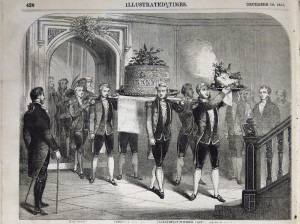It’s a line I use frequently, from our Christmas movie tradition, Mystery, Alaska, or second fave, Trailer Park Boys Christmas:
 The only fun things to do in cold weather are fornicate and play hockey.
The only fun things to do in cold weather are fornicate and play hockey.
If you are eating turkey this Christmas out of some sense of tradition, food historian Ivan Day says, put down that drumstick. After studying English cookbooks hundreds of years old, Day says the giant bird isn’t even that traditional. Besides, he says, “It’s a dry wasteland of flavorless meat.”
Sure, the first turkey came to England in the 1600s. It was an exotic “treat” from the New World. But a time traveler from Shakespeare’s time wouldn’t understand why everyone in the modern world was having the same dull bird on Christmas night.
At his farmhouse in northern England, Day collects old cookbooks and food illustrations. He says in olden days, Christmas celebrations were all about novelty and variety. The tables of the rich might include a turkey and a goose, but also peacocks, swans, partridges and plovers. A rack of venison would sit beside a giant turtle. The eating would go on for days.
Christmas used to be a 12-day drunken festival. Imagine Mardi Gras with snow. Cooks were always trying to top one another in outrageousness, from the traditional presentation of the boar’s head to the array of sickeningly sweet puddings. Day shows me a 19th-century illustration of a pie that took a crowd of servants to carry. It was filled with boned geese, woodcocks, hares and any other game they had around.
“This was the original turducken,” he says.
Ivan Day will be having beef roasted in front of an open fire for Christmas, and he says you really should stop and appreciate how Christmas must have felt to people, say, 400 years ago. They might have gone months eating the same thing every day, bacon and bread. The Christmas meal, with its exotic fruits and endless variety, must have felt like a miracle. “It was a moment of sunshine in a dreary year of grayness,” he says.
